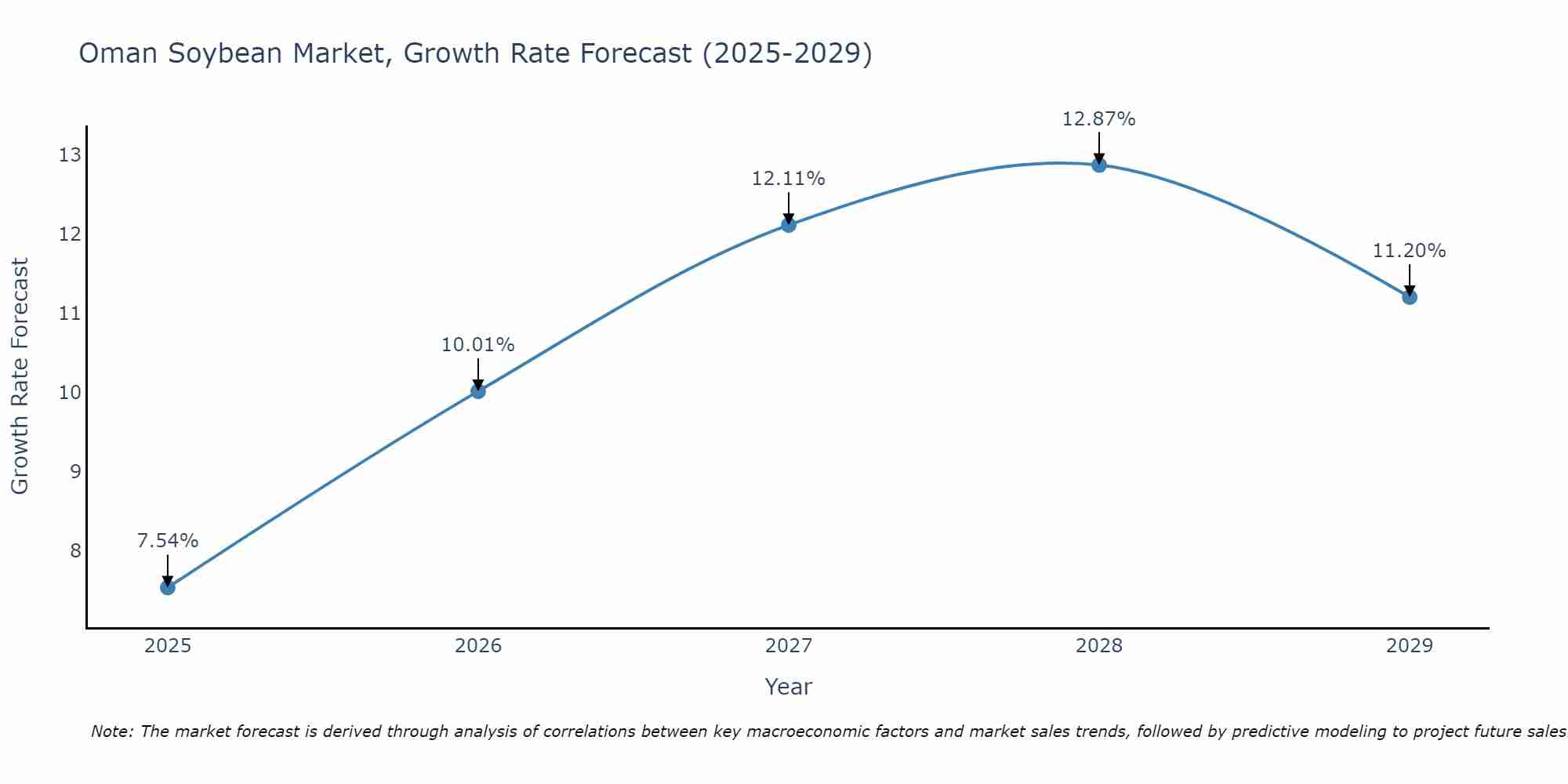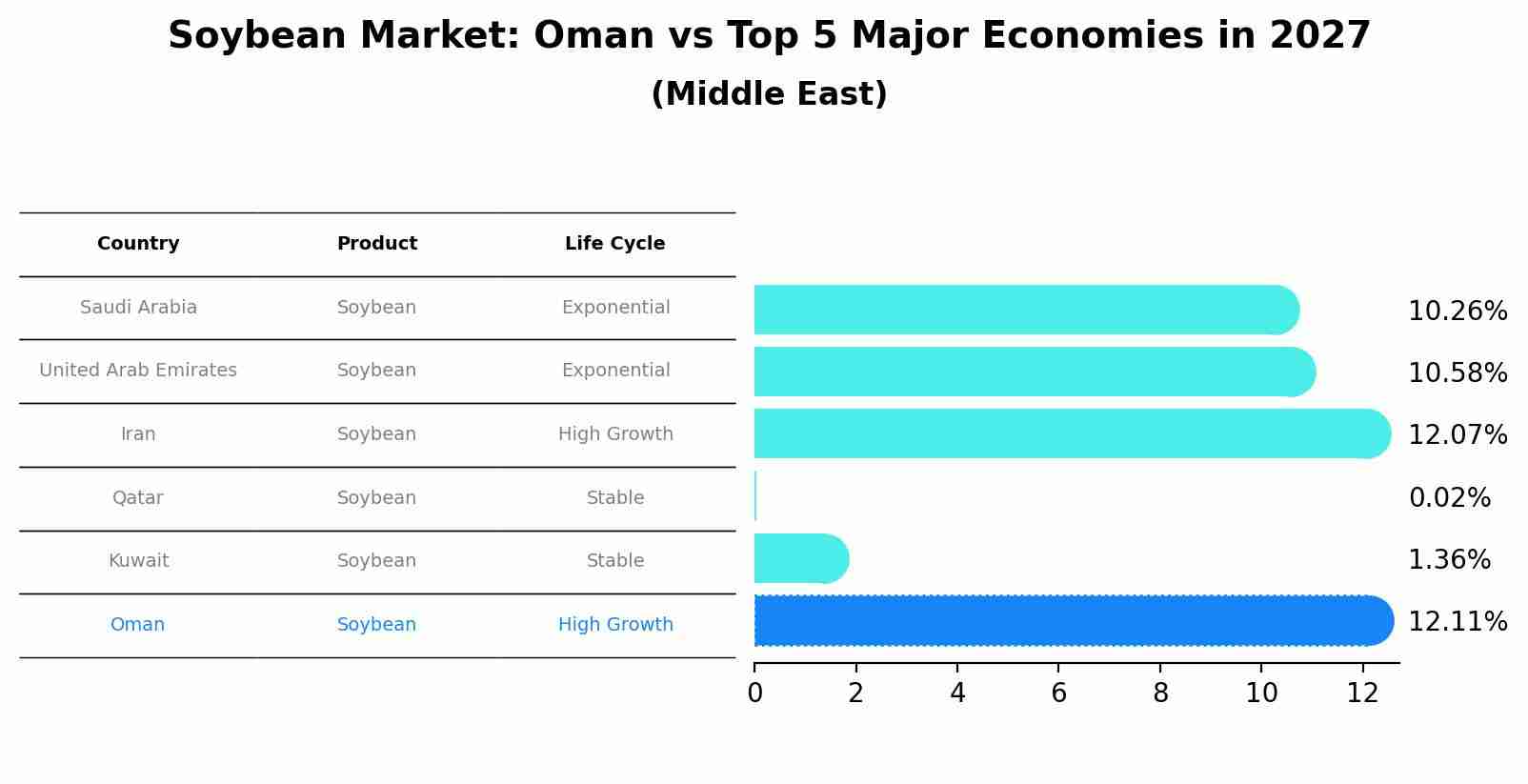Oman Soybean Market Outlook | Share, Trends, Value, Revenue, Growth, Forecast, Analysis, Industry, Size, COVID-19 IMPACT & Companies
| Product Code: ETC224683 | Publication Date: Aug 2022 | Updated Date: Jul 2025 | Product Type: Market Research Report | |
| Publisher: 6Wresearch | Author: Sumit Sagar | No. of Pages: 75 | No. of Figures: 35 | No. of Tables: 20 |
Oman Soybean Market Size Growth Rate
The Oman Soybean Market is projected to witness mixed growth rate patterns during 2025 to 2029. The growth rate begins at 7.54% in 2025, climbs to a high of 12.87% in 2028, and moderates to 11.20% by 2029.

Soybean Market: Oman vs Top 5 Major Economies in 2027 (Middle East)
In the Middle East region, the Soybean market in Oman is projected to expand at a high growth rate of 12.11% by 2027. The largest economy is Saudi Arabia, followed by United Arab Emirates, Iran, Qatar and Kuwait.

Oman Soybean Market Overview
The soybean market in Oman is influenced by factors such as increasing health consciousness among consumers, the rise in vegetarian and vegan diets, and the growing awareness of the nutritional benefits of soy products. The market is primarily driven by the food industry, with soybeans being used in various products such as tofu, soy milk, and meat substitutes. Additionally, the livestock feed sector is also a significant consumer of soybeans in Oman. The market is expected to witness steady growth in the coming years due to the increasing demand for plant-based protein sources and the expanding food processing industry in the country. However, challenges such as fluctuating prices, import regulations, and competition from other protein sources may impact the growth of the soybean market in Oman.
Oman Soybean Market Trends
The Oman Soybean Market is currently experiencing growth due to the increasing demand for soybean products in various industries such as food processing, animal feed, and biofuel production. There is a rising awareness among consumers about the health benefits of soy-based products, leading to a higher consumption rate. The market is also witnessing a shift towards sustainable and organic soybean production methods to meet the growing demand for environmentally friendly products. Additionally, the government`s initiatives to promote domestic soybean cultivation are further driving the market growth. Overall, the Oman Soybean Market is expected to continue its upward trajectory in the coming years, with opportunities for both local producers and international suppliers to capitalize on the expanding market potential.
Oman Soybean Market Challenges
In the Oman soybean market, one of the main challenges is the country`s heavy reliance on imports to meet its soybean demand. This dependence on imports exposes the market to fluctuations in international prices, currency exchange rates, and global supply chain disruptions. Additionally, the lack of domestic soybean production further exacerbates the vulnerability of the market to external factors. Limited availability of suitable agricultural land, water scarcity, and unfavorable climatic conditions in Oman hinder the development of a local soybean production industry. Furthermore, the need for advanced agricultural technologies and expertise poses a barrier to increasing domestic soybean cultivation. Addressing these challenges would require strategic investments in agricultural infrastructure, research and development, and policy support to enhance the resilience and sustainability of the Oman soybean market.
Oman Soybean Market Investment Opportunities
The Oman soybean market presents promising investment opportunities due to increasing demand driven by the growing popularity of soy-based products in the region. Investors can consider opportunities in soybean farming, processing facilities, and distribution networks to capitalize on this expanding market. Additionally, investing in research and development initiatives to improve soybean yields and quality can provide long-term growth potential. Collaborating with local farmers and government agencies to promote sustainable farming practices and ensure a stable supply chain can also be a strategic investment approach in the Oman soybean market. Overall, with the rising consumption of soybean products in Oman, investing in various segments of the soybean industry can offer attractive returns and contribute to the development of the market.
Oman Soybean Market Government Policy
The government of Oman has implemented policies to promote the growth of the soybean market in the country. These policies include providing subsidies and support to local farmers to increase soybean production, investing in research and development to enhance crop yield and quality, and establishing partnerships with international organizations to improve market access and export opportunities. Additionally, the government has introduced initiatives to encourage sustainable farming practices and ensure food security. Overall, these policies aim to boost the domestic soybean industry, reduce reliance on imports, and support the agricultural sector`s growth in Oman.
Oman Soybean Market Future Outlook
The future outlook for the Oman Soybean Market appears promising due to increasing consumer awareness of the health benefits associated with soy products. With a growing population and rising disposable incomes, there is a potential for greater demand for soybeans and soy-based products in Oman. Additionally, the government`s focus on promoting sustainable agriculture practices and diversifying the economy could lead to increased cultivation of soybeans domestically, reducing the country`s reliance on imports. However, challenges such as climate change, water scarcity, and global market fluctuations may impact the growth of the soybean market in Oman. Overall, advancements in technology and agricultural practices present opportunities for the Oman Soybean Market to expand and thrive in the coming years.
Key Highlights of the Report:
- Oman Soybean Market Outlook
- Market Size of Oman Soybean Market, 2021
- Forecast of Oman Soybean Market, 2031
- Historical Data and Forecast of Oman Soybean Revenues & Volume for the Period 2018 - 2031
- Oman Soybean Market Trend Evolution
- Oman Soybean Market Drivers and Challenges
- Oman Soybean Price Trends
- Oman Soybean Porter's Five Forces
- Oman Soybean Industry Life Cycle
- Historical Data and Forecast of Oman Soybean Market Revenues & Volume By Applications for the Period 2018 - 2031
- Historical Data and Forecast of Oman Soybean Market Revenues & Volume By Crush for the Period 2018 - 2031
- Historical Data and Forecast of Oman Soybean Market Revenues & Volume By Feed Use for the Period 2018 - 2031
- Historical Data and Forecast of Oman Soybean Market Revenues & Volume By Food Use for the Period 2018 - 2031
- Oman Soybean Import Export Trade Statistics
- Market Opportunity Assessment By Applications
- Oman Soybean Top Companies Market Share
- Oman Soybean Competitive Benchmarking By Technical and Operational Parameters
- Oman Soybean Company Profiles
- Oman Soybean Key Strategic Recommendations
Frequently Asked Questions About the Market Study (FAQs):
1 Executive Summary |
2 Introduction |
2.1 Key Highlights of the Report |
2.2 Report Description |
2.3 Market Scope & Segmentation |
2.4 Research Methodology |
2.5 Assumptions |
3 Oman Soybean Market Overview |
3.1 Oman Country Macro Economic Indicators |
3.2 Oman Soybean Market Revenues & Volume, 2021 & 2031F |
3.3 Oman Soybean Market - Industry Life Cycle |
3.4 Oman Soybean Market - Porter's Five Forces |
3.5 Oman Soybean Market Revenues & Volume Share, By Applications, 2021 & 2031F |
4 Oman Soybean Market Dynamics |
4.1 Impact Analysis |
4.2 Market Drivers |
4.3 Market Restraints |
5 Oman Soybean Market Trends |
6 Oman Soybean Market, By Types |
6.1 Oman Soybean Market, By Applications |
6.1.1 Overview and Analysis |
6.1.2 Oman Soybean Market Revenues & Volume, By Applications, 2021-2031F |
6.1.3 Oman Soybean Market Revenues & Volume, By Crush, 2021-2031F |
6.1.4 Oman Soybean Market Revenues & Volume, By Feed Use, 2021-2031F |
6.1.5 Oman Soybean Market Revenues & Volume, By Food Use, 2021-2031F |
7 Oman Soybean Market Import-Export Trade Statistics |
7.1 Oman Soybean Market Export to Major Countries |
7.2 Oman Soybean Market Imports from Major Countries |
8 Oman Soybean Market Key Performance Indicators |
9 Oman Soybean Market - Opportunity Assessment |
9.1 Oman Soybean Market Opportunity Assessment, By Applications, 2021 & 2031F |
10 Oman Soybean Market - Competitive Landscape |
10.1 Oman Soybean Market Revenue Share, By Companies, 2021 |
10.2 Oman Soybean Market Competitive Benchmarking, By Operating and Technical Parameters |
11 Company Profiles |
12 Recommendations |
13 Disclaimer |
- Single User License$ 1,995
- Department License$ 2,400
- Site License$ 3,120
- Global License$ 3,795
Search
Thought Leadership and Analyst Meet
Our Clients
Related Reports
- Afghanistan Apparel Market (2026-2032) | Growth, Outlook, Industry, Segmentation, Forecast, Size, Companies, Trends, Value, Share, Analysis & Revenue
- Canada Oil and Gas Market (2026-2032) | Share, Segmentation, Value, Industry, Trends, Forecast, Analysis, Size & Revenue, Growth, Competitive Landscape, Outlook, Companies
- Germany Breakfast Food Market (2026-2032) | Industry, Share, Growth, Size, Companies, Value, Analysis, Revenue, Trends, Forecast & Outlook
- Australia Briquette Market (2025-2031) | Growth, Size, Revenue, Forecast, Analysis, Trends, Value, Share, Industry & Companies
- Vietnam System Integrator Market (2025-2031) | Size, Companies, Analysis, Industry, Value, Forecast, Growth, Trends, Revenue & Share
- ASEAN and Thailand Brain Health Supplements Market (2025-2031) | Strategy, Consumer Insights, Analysis, Investment Trends, Opportunities, Growth, Size, Share, Industry, Revenue, Segments, Value, Segmentation, Supply, Forecast, Restraints, Outlook, Competition, Drivers, Trends, Demand, Pricing Analysis, Competitive, Strategic Insights, Companies, Challenges
- ASEAN Bearings Market (2025-2031) | Strategy, Consumer Insights, Analysis, Investment Trends, Opportunities, Growth, Size, Share, Industry, Revenue, Segments, Value, Segmentation, Supply, Forecast, Restraints, Outlook, Competition, Drivers, Trends, Demand, Pricing Analysis, Competitive, Strategic Insights, Companies, Challenges
- Europe Flooring Market (2025-2031) | Outlook, Share, Industry, Trends, Forecast, Companies, Revenue, Size, Analysis, Growth & Value
- Saudi Arabia Manlift Market (2025-2031) | Outlook, Size, Growth, Trends, Companies, Industry, Revenue, Value, Share, Forecast & Analysis
- Uganda Excavator, Crane, and Wheel Loaders Market (2025-2031) | Strategy, Consumer Insights, Analysis, Investment Trends, Opportunities, Growth, Size, Share, Industry, Revenue, Segments, Value, Segmentation, Supply, Forecast, Restraints, Outlook, Competition, Drivers, Trends, Demand, Pricing Analysis, Competitive, Strategic Insights, Companies, Challenges
Industry Events and Analyst Meet
Whitepaper
- Middle East & Africa Commercial Security Market Click here to view more.
- Middle East & Africa Fire Safety Systems & Equipment Market Click here to view more.
- GCC Drone Market Click here to view more.
- Middle East Lighting Fixture Market Click here to view more.
- GCC Physical & Perimeter Security Market Click here to view more.
6WResearch In News
- Doha a strategic location for EV manufacturing hub: IPA Qatar
- Demand for luxury TVs surging in the GCC, says Samsung
- Empowering Growth: The Thriving Journey of Bangladesh’s Cable Industry
- Demand for luxury TVs surging in the GCC, says Samsung
- Video call with a traditional healer? Once unthinkable, it’s now common in South Africa
- Intelligent Buildings To Smooth GCC’s Path To Net Zero


















